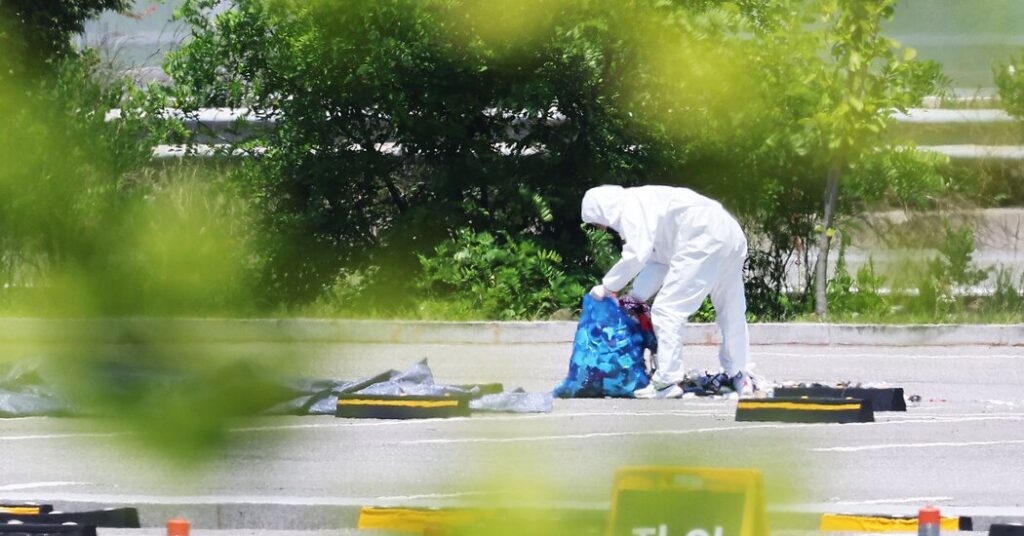On Saturday night, North Korea launched 720 balloons across the world’s most heavily armed border with South Korea’s payload: plastic bags filled with cigarette butts and other trash.
Since last Tuesday, North Korea has launched about 1,000 garbage balloons into the demilitarized zone that separates South and North Korea. Once the balloon reaches South Korean airspace, a timer releases a plastic bag filled with various trash, including scraps of paper and cloth.
South Korea’s military denied initial reports that the balloons were carrying human waste, but did note that some of the trash appeared to be compost.
So far, South Korean authorities have not found “any dangerous substances” in the payload. On Sunday, South Korean President Yoon Seok-yeol’s office accused North Korea of carrying out “dirty provocations that a normal country would not think of.” The statement said South Korea would begin taking “steps that North Korea cannot tolerate.”
North Korean officials have said they may turn on loudspeakers along the border to play K-pop music, which leader Kim Jong Un considers so threatening that he once called it a “malignant cancer.”
North Korea calls the floating offensive a “tit-for-tat operation.” It accused North Korean defectors living in South Korea of ”distributing leaflets and all kinds of dirty things” in its border counties in recent days.
Here’s some information about this unusual offensive.
It was disturbing, but not damaging.
When South Korea reports objects launched from North Korea, they are usually rockets carrying satellites or what North Korea says are ballistic missiles capable of delivering nuclear warheads. But North Korea’s actions over the past week have been a revival of a Cold War-era tactic: using propaganda balloons as psychological warfare.
There was some confusion and public complaints over last week’s balloon offensive, when the government mistakenly warned people near the border of “air raids.”
Most South Koreans remained calm, dismissing the incident as nothing more than irritating antics by North Korea. People posted photos on social media of North Korean balloons in trees, on farmland or in city alleys strewn with trash. A plastic bag dropped from the balloon was heavy enough to destroy the windshield of a parked car, according to photos published by local news outlets.
But there was an ominous undertone when South Korea urged people not to touch the balloons and report them to authorities immediately. North Korea is known to possess vast quantities of biological and chemical weapons, which its agents used to assassinate Kim Jong Un’s estranged half-brother, Kim Jong Nam.
Photos and videos released by South Korea’s military on Sunday showed officers wearing biohazard suits and bomb disposal equipment inspecting the trash pile.
The balloon competition goes back decades.
During the Cold War, North and South Korea engaged in psychological warfare. They attempted to influence each other’s citizens through shortwave radio broadcasts filled with propaganda. Along the DMZ, loudspeakers bombard enemy soldiers with propaganda songs day and night. Advertising boards urged soldiers to defect to the “people’s paradise” of the North or the “free and democratic” South.
North and South Korea also launched balloons carrying leaflets into each other’s airspace. Millions of these slanderous leaflets are scattered across the Korean peninsula, with both North and South Korea prohibiting their people from reading or retaining the material. In the South, children were rewarded with pencils and other school supplies when police spotted flyers in the mountains and reported them.
But until recently, balloons from North Korea rarely carried ordinary trash.
A court ruling allowed the balloon to fly again.
By the 1990s, with South Korea’s rapid economic development, North Korea’s propaganda had apparently lost its meaning. The South has emerged as a vibrant democracy and global export powerhouse, while the North suffers from chronic food shortages and relies on a cult of personality and a total information blackout to control its people.
When the two leaders held their first inter-Korean summit in 2000, the two Koreas agreed to end government-sponsored activities that affected each other’s citizens. But North Korean defectors and conservative and Christian activists in South Korea continue to wage an information war, sending balloons filled with mini-Bibles, transistor radios, household medicines, computer thumb drives containing K-pop music and drama and leaflets calling Kim Jong-un. pig.
To them, their payload consists of “truth” and “freedom of speech” that will help awaken North Koreans from their government’s brainwashing. To Pyongyang, they are nothing more than political “dirt” and the North Korean leader has vowed to retaliate in kind.
The Seoul government subsequently enacted a law banning the sending of leaflets to North Korea, saying they were nothing more than provocations to Pyongyang. But a few years later, in 2023, a court ruled that the law was unconstitutional, and last month activists resumed launching balloons.
“We have tried what they have been doing, but I don’t understand why they are making a fuss, like being hit by a hail of bullets,” Kim Jong Un’s sister and spokesman Kim Yo Jong said last week. “If they realize how uncomfortable and tiring it feels to pick up dirt, they will know that speaking out about free speech is not easy.”

